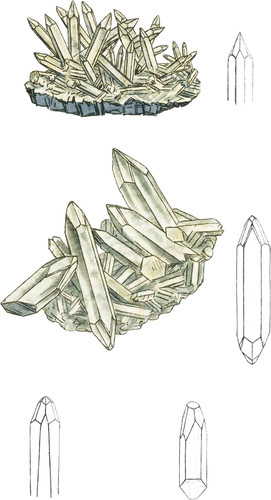 Enlarge
Enlarge
British Mineralogy
Carbonate of Lime
- Div 1. Crystallized.
Carbonate of Lime is so abundant in varieties and modifications of its crystals, that we shall select only such specimens as show something peculiar or instructive. In the present instance we exhibit it with longer prisms than usual, which help to give it the aspect of Quartz, which is so common with a longish prism. Some specimens, but such are somewhat rare, are not far inferior in lustre and transparency to Quartz, but, like Diamonds and other diaphanous brilliant subjects, would be best understood by comparison. Perhaps the brightest Carbonate of Lime would be, in comparison to Quartz, as cut Paste is to Diamonds; so that even the most experienced must try the coldness or hardness, to help his judgement. The first method would not hurt the Paste or Carbonate of Lime, but the latter would damage them; and specimens have now and then been hurt by trial. We have, however, the form of the pyramid to judge by; for Carbonate of Lime never has been found with the obtuse equiangular six-sided pyramid of Quartz, or representing any of the numerous varieties of it:—thus the structure points out a distinction which, when understood, is discerned in an instant. The present figure, therefore, exhibits not only a rare specimen of Carbonate of Lime, but some varieties in the facets of the pyramids. The upper figure is a small group with pointed endings. The lower figure has the same faces with lateral additions, and one is terminated at both ends. I have added parts of two other varieties underneath, which occasionally form groups. The upper right hand geometrical outline shows one end of a crystal with a narrow face, which is placed upon the acute edge of the pyramid. The next outline beneath exhibits narrow faces on the terminal edges of the prism, with a minute truncation upon the acute angle, making three additional facets to each solid angle: the obtuse end contains three of the primitive faces. I have a group to correspond with the faces of the column, alternating narrow at one end and broader at the other. The right hand figure has an equiangular pyramid with a truncated apex, nearly like Haüy’s fig. 32. This is rare: it is from Derbyshire.

